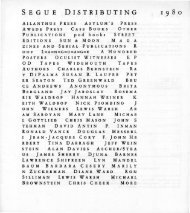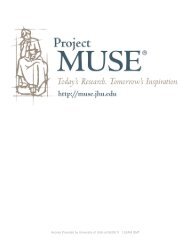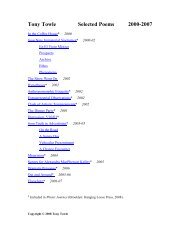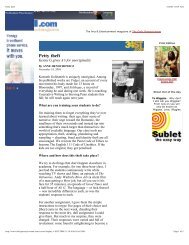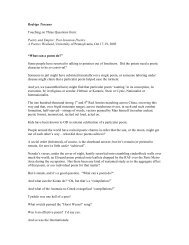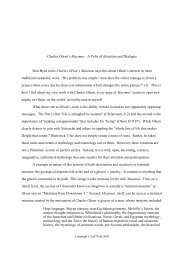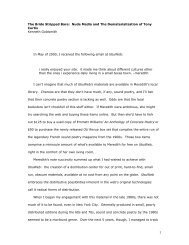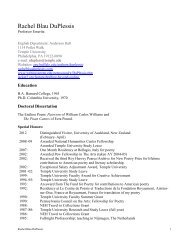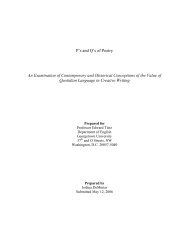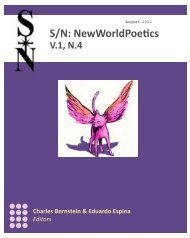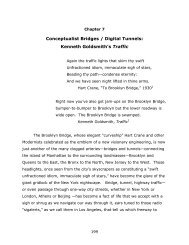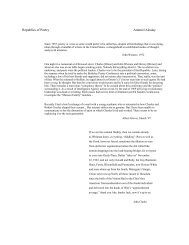Poetry & Poetics at Buffalo - Electronic Poetry Center - University at ...
Poetry & Poetics at Buffalo - Electronic Poetry Center - University at ...
Poetry & Poetics at Buffalo - Electronic Poetry Center - University at ...
Create successful ePaper yourself
Turn your PDF publications into a flip-book with our unique Google optimized e-Paper software.
257-----------------1\19701<br />
Max Wickert founds the Outriders <strong>Poetry</strong> Program, which sponsors weekly poetry readings<br />
<strong>at</strong> the Tralfamadore Cafe on Main Street.<br />
March 17-Paul Blackburn reads <strong>at</strong> Norton.<br />
April 29-Kenneth Koch reads <strong>at</strong> Norton.<br />
Allen Ginsberg reads in Clark Gym. Se<strong>at</strong>ed in the front row, "The Motherfuckers" (a registered<br />
trademark of a local commune) shout him down.<br />
May-First public<strong>at</strong>ion of F<strong>at</strong>har, edited by<br />
Duncan McNaughton. This journal, published in<br />
<strong>Buffalo</strong> and Bolinas from 1970 to 1975, is a beautiful<br />
example ofwh<strong>at</strong> can happen when a fine-press<br />
aesthetic has to negoti<strong>at</strong>e the financial limit<strong>at</strong>ions<br />
of the self-published poetry journal. Each of the six<br />
issues is bound in heavy stock with a single-color<br />
photoreproduction on the front cover. The papers<br />
used are slightly heavier than average, and are<br />
often selected in colors which contrast the covers.<br />
Texts are mimeographed, and are displayed recto<br />
side only.<br />
The range of poets and prose writers<br />
published here occupies a space largely mapped<br />
out between Olson's and Duncan's work. The<br />
occasional appearance of a New York School poet<br />
adds a bit of geographic scope, however (see the<br />
poems by O'Hara and Berrigan in no. 1), while<br />
arrivals from abroad (e.g., Tom Raworth in issue<br />
"Zayin" [which appeared in place of no. 4]) and the<br />
emergence of younger writers, some of them with <strong>Buffalo</strong> backgrounds (see Michael<br />
Davidson in no. 5), signal the early stirrings of something "new."<br />
---------119711<br />
"The art scene in <strong>Buffalo</strong> was booming in the '60s; there was this huge expansiveness from<br />
social changes like the Civil Rights movement and in the arts an experimentalism th<strong>at</strong><br />
made it seem like you couldn't even get to all the things th<strong>at</strong> were going on <strong>at</strong> once. The<br />
community and university and the<strong>at</strong>ers were all enmeshed. You had the feeling th<strong>at</strong> all<br />
around you was the possibility of hearing or seeing something never heard before. Of<br />
course, you probably saw some mediocre things but experiment<strong>at</strong>ion necessit<strong>at</strong>es failure.<br />
There was an audience for it back then, back before the retrenchment and vast cynicism<br />
of the 1970s. For a short time there was a benevolent enthusiasm for the new and a<br />
willingness to respond to new art forms."-ASB<br />
June 11-14-COSMEP holds its annual conference in <strong>Buffalo</strong>. The event includes a panel<br />
discussion (S<strong>at</strong>urday, June 13) on "Little Mags/Small Presses and the 'Cultural<br />
Revolution.'" Panel members are Robert Creeley, Leslie Fiedler, Allen Ginsberg, Susan<br />
Sherman, and John Wieners.



